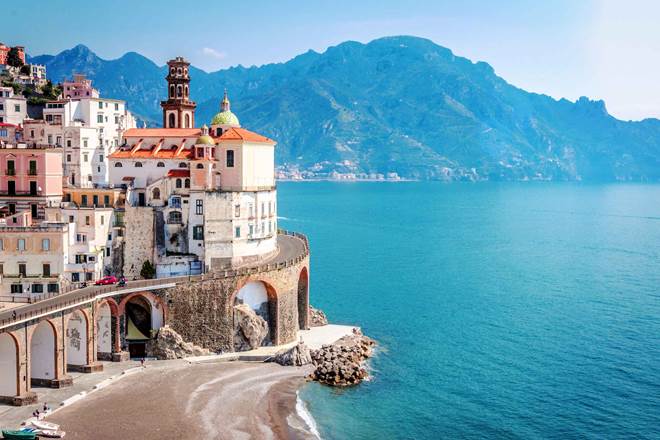How to get to the Amalfi Coast by train
Getting to Vietri sul Mare by train
The best way to get to the Amalfi Coast is to take a train from Naples or Salerno to Vietri sul Mare-Amalfi, the only train station you can find in this stunning area. The journey time from Naples to Vietri sul Mare-Amalfi lasts less than an hour, while it takes only 8 minutes to get from Salerno to Vietri sul Mare-Amalfi. These routes are operated by Trenitalia's regional trains. Once you get off your train, head to the city centre of Vietri sul Mare and wander through the narrow streets enriched by the tiled and colourful shopfronts before embarking on your adventure in the other coastal towns. Local buses operated by Sita will help you move from one town to the other.
Getting to Sorrento by train
Alternatively, if you're travelling from Rome, you can easily get to Sorrento thanks to the FrecciaLink service offered by Trenitalia – simply take a Frecciarossa train to Napoli Centrale and then hop on the FrecciaLink bus bound for Sorrento. Just remember that this service is only available on weekends. On Frecciarossa trains you can enjoy many high-quality onboard services, including free WiFi, a welcome service with complimentary food and drinks and an onboard entertainment portal. Moreover, if you buy a Frecciarossa Executive (First Class) ticket, you can get free access to FrecciaLounge, which comes with free WiFi, customer service, complimentary drinks, snacks and newspapers – that's the perfect place to be while waiting for your train at Roma Termini.
Once in Sorrento, you can hop on one of the buses that go to Amalfi. Allow plenty of time to catch your Amalfi coast bus at peak periods as there will be long queues. From Sorrento to Amalfi, sit on the right-hand side for the sea and stunning views, especially as the road twists and turns into Positano. On arrival into Positano, make sure you get off at the Sponda stop rather than up at the church to save your knees a long schlepp down to the waterfront. When taking the boat from Positano to Amalfi, go upstairs for the best views and grab a seat on the left-hand side.
Amalfi
After around half an hour, the boat pulls up alongside the jetty in Amalfi's pretty bay. You could be forgiven for thinking that the plethora of cafes and souvenir shops along the waterfront are reasons enough for a visit, but duck under the alleyway and the most incredible church – the Duomo – is revealed in the square behind. Adorned with gilded mosaics and decorated inside with frescoes, it occupies pride of place up a flight of steps directly off the piazza. One thing you might notice is the lack of old buildings – a large earthquake back in the fourteenth century holds the key to the mystery, as the former maritime superpower collapsed and was claimed by the sea. While the church was rebuilt, most other historic buildings were not. Since you're in a coastal town, don't miss your chance to taste delicious and fresh seafood, including fried fish.
Ravello
One last village you shouldn't miss is Ravello. Reached from Amalfi by a switchback mountain road that takes you inland through Valle del Dragone, the village is centred around a pretty square. In the corner sits Villa Rufolo, with its distinctive ageing towers and beautiful gardens designed by the Scot Francis Neville Reid in the nineteenth century. Opposite, surrounded by pavement cafes, is the cathedral, whose interior is worth more than a cursory glance. If you're a music lover, you'll be delighted to know that a series of concerts are staged as part of the Ravello Festival through spring and summer.
Positano
Famous for its colourful buildings, excellent restaurants and ideal location, Positano is one of the most typical towns of the Amalfi Coast. Wander through a maze of narrow alleys and climb steep flights of steps to get from the town and its beach to the coast road way up above. Lining these passages are hundreds of shops selling clothes, souvenirs and household goods. At the top of the cliff is the stunning Chiesa di Santa Maria Assunta, which prevails over the rest of the landscape with its green and golden-tiled domed roof.
